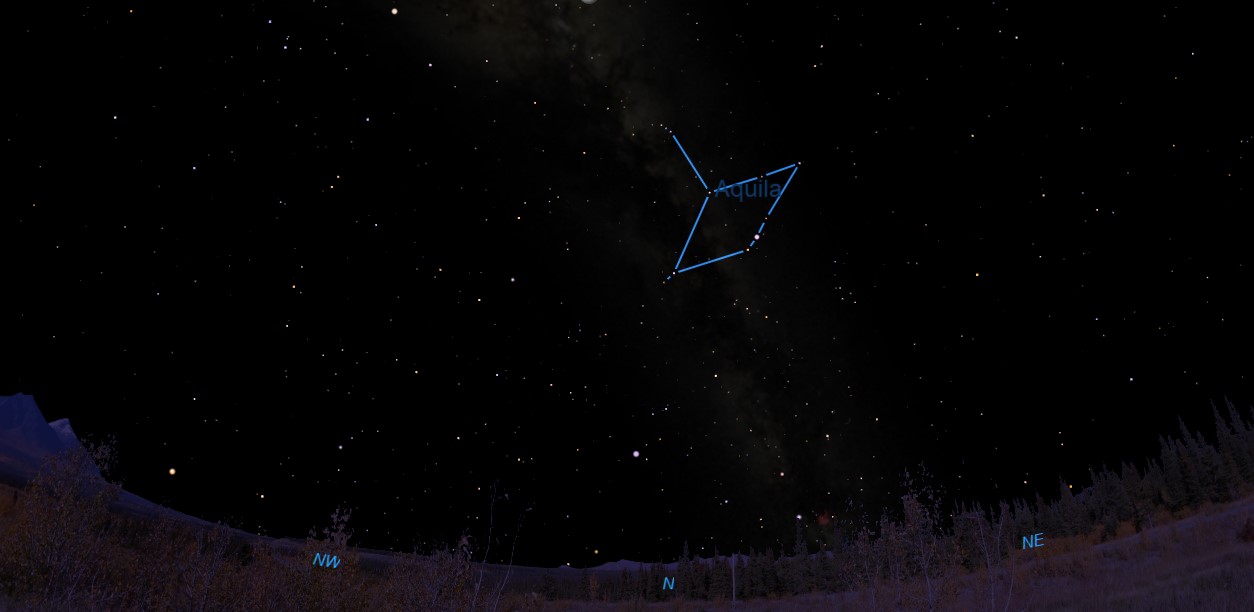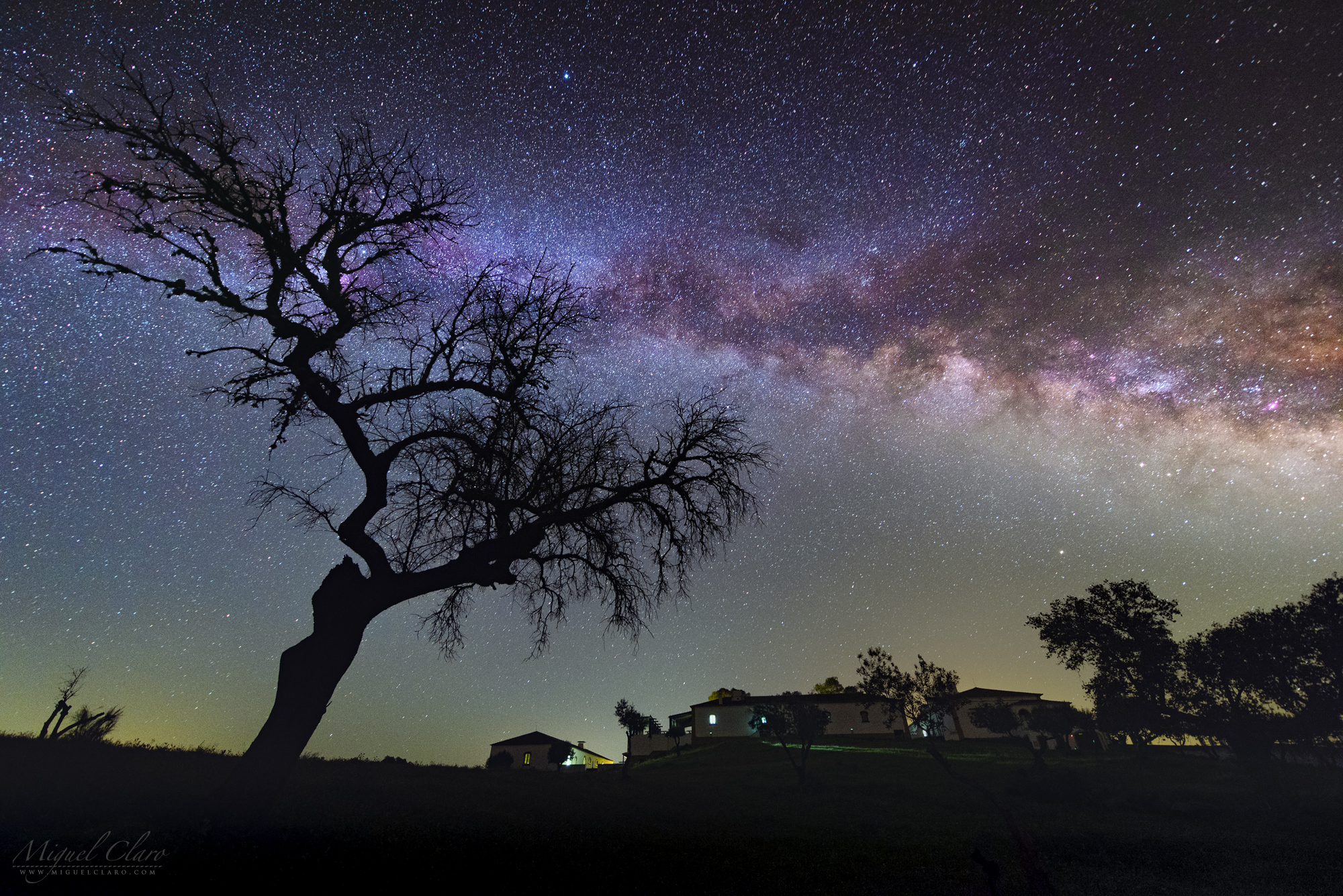
If you look high up in the southern sky this week around midnight, you'll be able to see a pattern of stars that — at least to me — resembles a jet plane flying in a southbound direction.
Of course, well before the invention of such flying machines, ancient stargazers visualized something else among these stars that soared across the sky: an eagle, which they named Aquila.
Whether you envision it as a great bird or an aircraft, Aquila is certainly impressive. Its distinguishing feature is the head, which is composed of a line of three stars. These are easily recognized because they are close together, nearly equally spaced and lie at some distance from any other bright star.
This trio is sometimes referred to as the "Family of Aquila" or the "Shaft of Aquila." They are a summer landmark with one faint star, another of medium brightness and the middle star by far the brightest: yellowish-white Altair, the 12th brightest star in the sky.
Related: The Brightest Visible Planets in July's Night Sky: How to See them (and When)
Whirling luminary
Altair owes its brightness chiefly to its closeness to us. Next to Alpha Centauri, Sirius and Procyon, Altair is our closest neighbor among the brightest stars at just 16.7 light-years away. With each passing minute we get 1,000 miles (1,600 kilometers) closer to Altair.
Altair is not a particularly large star despite being twice as massive as our sun and about 11 times more luminous. What is particularly interesting is how quickly Altair rotates on its axis. Our sun takes about 25 days to turn once on its axis. Altair takes only 9 hours! As a result, Altair's shape is distorted into an oblate spheroid.
Get the Space.com Newsletter
Breaking space news, the latest updates on rocket launches, skywatching events and more!
Stellar balloon
Another interesting star can be found in the Eagle's left wing, Eta (η) Aquilae. This supergiant star is a bright Cepheid variable that changes by nearly a full magnitude in brightness (3.5 to 4.4) over a little more than a week.
Its period is 7 days, 4 hours and 14 minutes. For 40 hours, it shines at peak brightness, rivaling the star to the immediate left of Altair, known as Alshain. Then for 66 hours, it "deflates" until, for about 30 hours, it reaches minimum size and brightness and shines less than half as bright as it was at maximum. It is located about 1,400 light-years from us.
A tough old bird
Aquila is a truly ancient star pattern and one of the original 48 constellations identified by the second-century astronomer, Claudius Ptolemy (A.D. 100-170). But the pattern had been noted even earlier by the Greek astronomer Eudoxus of Cnidus (390?-337 B.C.) in the fourth century B.C. and by the Greek didactic poet Aratus (313?-240 B.C.) in the third century B.C.
Aquila was also identified as an eagle by astronomers of the Euphrates River Basin, and the constellation takes its name from the bird that carried the thunderbolts of the Greek god Zeus. It is said that the Eagle originally took its place among the stars because it was the only bird with wings powerful enough to carry it the long distance that divided heaven from Earth.
Aquila's main accomplishment was to bring up to the sky in his talons the handsome mortal youth Ganymede to serve as Zeus' cupbearer. The pair are still seen in the stars to this day, one above the other: Aquila as the Eagle and the zodiacal constellation of Aquarius the Water Bearer, representing Ganymede.

Star-crossed lovers in the sky
Aquila is located within one of the brightest parts of the Milky Way. From a location far from bright lights, we can see the Milky Way right now as a glowing, irregular belt of luminosity, with a great black rift dividing it into two streams. On a clear, dark evening it's a wonderful sight, and if you look at it with binoculars you will see so many faint stars that to count them would be incredibly difficult. Altair is one of three stars that form the famous "Summer Triangle" along with bright white Deneb in Cygnus the Swan and the brilliant bluish-white Vega in Lyra the Lyre.
To certain Native Americans, the Milky Way was the path of their braves into heaven, with bright stars like Vega and Altair representing campfires along the way.
There is also a very poignant Japanese legend involving these two stars and the Milky Way. Vega represented Orihime, who produced brilliantly colored fabrics. Across the "Heavenly River" (the Milky Way), Altair represented the cowherd Kengyu. After meeting each other, they received divine permission to marry, whereupon both abandoned their occupations. This angered the gods, who separated them and sent them back to their original jobs on opposite sides of the Heavenly River.
The couple however, received permission from the gods to get together for one night each year on July 7, but only if the sky is clear. But how did they get across the Heavenly River? Friendly magpies formed a fluttering bridge across the glowing stream on which the couple could meet.
This tale of the magpies was such a favorite, it is said that children would pursue any magpie they chanced to see on that special day of the year, and scolded it for neglecting its duty. As a result, the evening of July 7 has become a young-people's holiday in Japan called Tanabata. Prayers are then offered for clear skies so that Orihime and Kengyu, the star-crossed lovers, can be reunited.
And when the birds reappear on the following day, their heads are said to be bald, the feathers having been worn off by the feet of Orihime as she crossed the bridge.
- Best Night Sky Events of July 2019 (Stargazing Maps)
- July Full Moon 2019: 'Thunder Moon' Lunar Eclipse Meets Saturn in the Night Sky
- Night Sky, July 2019: What You Can See This Month [Maps]
Joe Rao serves as an instructor and guest lecturer at New York's Hayden Planetarium. He writes about astronomy for Natural History magazine, the Farmers' Almanac and other publications, and he is also an on-camera meteorologist for Verizon FiOS1 News in New York's lower Hudson Valley. Follow us on Twitter @Spacedotcom and on Facebook.
Join our Space Forums to keep talking space on the latest missions, night sky and more! And if you have a news tip, correction or comment, let us know at: community@space.com.

Joe Rao is Space.com's skywatching columnist, as well as a veteran meteorologist and eclipse chaser who also serves as an instructor and guest lecturer at New York's Hayden Planetarium. He writes about astronomy for Natural History magazine, Sky & Telescope and other publications. Joe is an 8-time Emmy-nominated meteorologist who served the Putnam Valley region of New York for over 21 years. You can find him on Twitter and YouTube tracking lunar and solar eclipses, meteor showers and more. To find out Joe's latest project, visit him on Twitter.
